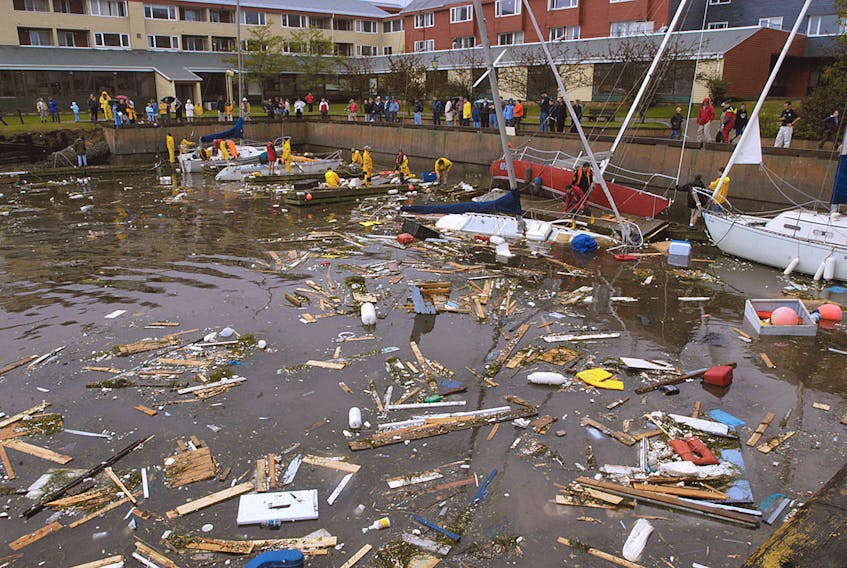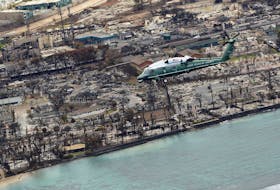Doug Gaudet can still remember waking up to the devastating phone call on Sept. 29, 2003.
The Charlottetown Yacht Club member had spent much of the night before at the marina with others watching over vessels in anticipation of destruction wreaked by hurricane Juan.
However, with only about “six inches of ripple” in the more sheltered area of the marina, Gaudet felt confident his boat, C.C. Comfort (Cheap Canadian Comfort), was secure and decided to go home around 2:30 a.m.
It was only a few hours later, around 6 a.m., when he got the call.
“(They said) ‘Don’t rush, there’s nothing you can do about it, but you better come down’,” said Gaudet, while looking over a picture of the hurricane’s aftermath that is now in the club’s display case.
Among the wreckage in the picture is Gaudet’s boat, which was written off with an 18-foot-hole in its side.
Gaudet said a shift of winds resulted in that six inches of ripple growing to 10-foot waves within just a few minutes.
“There were about 22 boats up in the corner… they were all piled up with the (destroyed) docks we had beside us still tied to them,” said Gaudet, who recalled some individuals tying down equipment and taking their boats out of the water the day before Juan. “Everybody thought we were pretty tied down. The only thing that could really go wrong is if it was a direct hit.”

However, nobody could have imagined the destructive impact left on the marina, which saw at least seven boats sink and many more damaged beyond repair, as well as the devastation that swept across the province.
The impact left by hurricane Juan 15 years ago today became a wake-up call to many Islanders on the potential for severe weather in the province and has since shaped how organizations and individuals prepare for emergencies.
“People know our vulnerabilities and are certainly a lot more aware of what our risks are… you remember what you were doing and what the loss felt like (after Juan),” said Tanya Mullally, the emergency management co-ordinator with P.E.I.’s Emergency Measures Organization (EMO).
“There have been some pretty significant things we’ve done as a province and, I would say, even within Atlantic Canada to really boost our capacity and resilience around hurricane response.”
The EMO delivered one course in 2003. It now offers 12 to 15 different emergency management courses throughout each year.
Mullally said the province’s new Municipal Government Act, which requires communities to have an emergency response plan in place, will help make sure Islanders are better prepared at the municipal level.
The EMO has also since strengthened its relationship with the Canadian Hurricane Centre, as well as with other provincial EMOs, to get a quicker and more accurate forecast of severe weather.
This, along with the emergence of social media, also provides a better opportunity to inform the public.
Fast facts
- At its height, hurricane Juan left nearly two-thirds of P.E.I. without power.
- The storm reached the Island on Sept. 29 at 3:17 a.m. with winds of 139 km/h. By the time it reached Charlottetown, winds peaked at 146 km/h. Technically, the hurricane was downgraded to a tropical storm by the time it hit P.E.I.
- The hurricane didn’t stop Islanders from voting in a provincial election later the same day, albeit by candlelight, with an 82 per cent turnout. Premier Pat Binns watched his decisive victory on a TV plugged into a generator in his Hopefield home.
Because Juan occurred overnight on a Sunday, Mullally said it was challenging to give an updated warning to the public.
Bob Boyle was one of many Islanders who knew the hurricane was coming but never expected its strength.
Boyle, whose family owns and operates the Brackley Drive-In, woke up to find the giant screen destroyed.
“I don’t think anybody was expecting the storm to be that strong at the time,” said Boyle.
Yacht club member and skipper David Smith said many did not expect the destruction because of the lack of hurricane experience in P.E.I.
“At one point, the marina basically looked like a washing machine. It was boats and pieces just smashing into each other,” said Smith.
Smith added that taking a boat completely out of the water is not a decision that is lightly made. Depending on the size, it can cost hundreds of dollars and takes plenty of time. That cost doubles if the boat has to go back in for the rest of the season.
Smith recalled some of the damage he witnessed at the marina.
RELATED
- St. F.X. professor's research helps people cope with anxiety over storms
- Storm warnings: Thanks to slowing Gulf Stream, weather is getting rougher
- PHOTOS: Hurricane Juan hits the Maritimes
- Hurricane Juan's path displaced outhouse, rabbit and trampoline for P.E.I. residents
The club’s general manager Lisa MacKinnon, who had been working in the front office for about a year before the storm hit, said the club has since changed how it approaches severe weather. Emails are now sent to members to warn them of any possible weather systems that could cause damage.
Since Juan’s impact, the club has also enacted a mandatory haul-out policy when winds are forecast to be a certain strength.
That policy has been enacted twice since Juan. One of those was during Hurricane Arthur in 2014, during which two boats that didn’t follow the order.
Both ended up with broken masts.
While MacKinnon noted that the other incident resulted in little wind, but it was “better to be safe than sorry.”
She also noted the resiliency of club members, many of whom came together after Juan to clear out debris, lift boats from the water and rebuild docks.
“We have a great group of people. It’s teamwork between staff, members and friends,” said MacKinnon. “Even on (last) Saturday, when winds were high, there were a number of members down there keeping an eye on other people’s boats.”
At the drive-in, Boyle was able to avoid a $100,000 expense when the family was fortunate to recycle a screen from the defunct Summerside Drive-In.
While there is little Boyle can do to prepare differently for future events, he said the previous damage often goes through his mind when severe weather is in the forecast.
It also left him with a greater perspective when he sees other provinces or countries going through a hurricane.
“I can empathize with what they’re going through… I kind of know what it’s like to wake up the next morning and wonder how you’ll rebuild,” said Boyle, who believes most Islanders became more weather-conscious after Juan.
“Until you’ve gone through it, I guess you don’t really think about it. That’s the after effect.”









